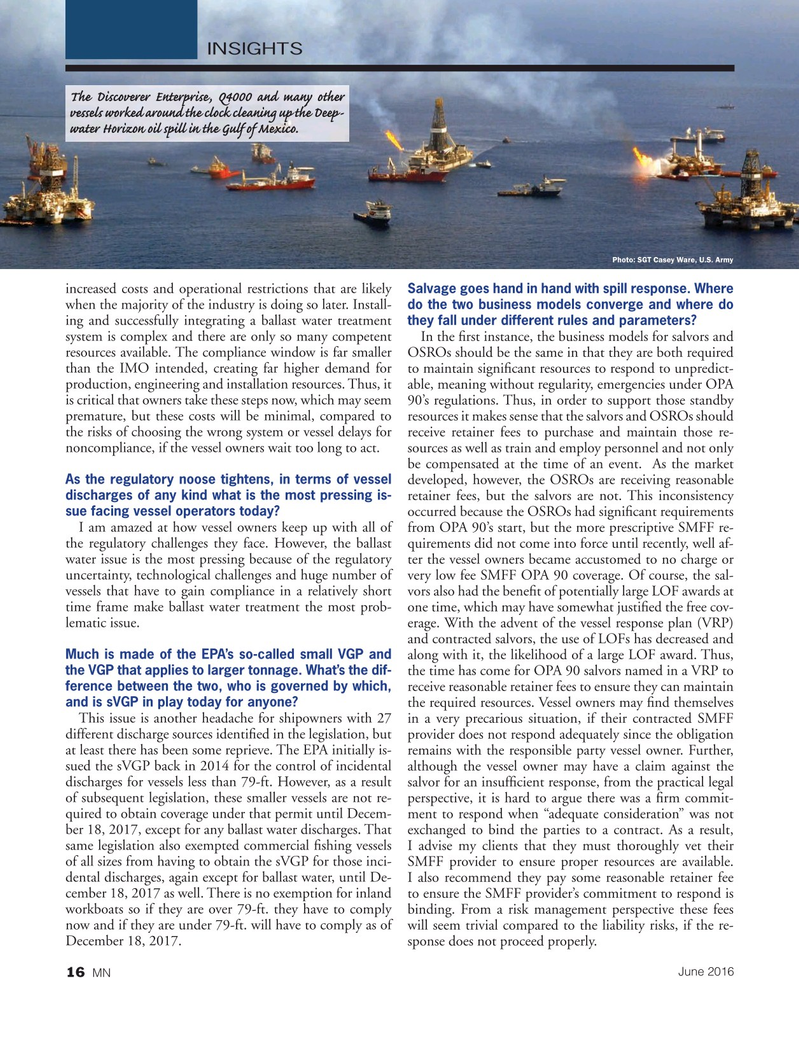
Page 16: of Marine News Magazine (June 2016)
Combat & Patrol Craft Annual
Read this page in Pdf, Flash or Html5 edition of June 2016 Marine News Magazine
INSIGHTS
The Discoverer Enterprise, Q4000 and many other vessels worked around the clock cleaning up the Deep- water Horizon oil spill in the Gulf of Mexico.
Photo: SGT Casey Ware, U.S. Army increased costs and operational restrictions that are likely
Salvage goes hand in hand with spill response. Where when the majority of the industry is doing so later. Install- do the two business models converge and where do ing and successfully integrating a ballast water treatment they fall under different rules and parameters?
system is complex and there are only so many competent In the ? rst instance, the business models for salvors and resources available. The compliance window is far smaller OSROs should be the same in that they are both required than the IMO intended, creating far higher demand for to maintain signi? cant resources to respond to unpredict- production, engineering and installation resources. Thus, it able, meaning without regularity, emergencies under OPA is critical that owners take these steps now, which may seem 90’s regulations. Thus, in order to support those standby premature, but these costs will be minimal, compared to resources it makes sense that the salvors and OSROs should the risks of choosing the wrong system or vessel delays for receive retainer fees to purchase and maintain those re- noncompliance, if the vessel owners wait too long to act. sources as well as train and employ personnel and not only be compensated at the time of an event. As the market
As the regulatory noose tightens, in terms of vessel developed, however, the OSROs are receiving reasonable discharges of any kind what is the most pressing is- retainer fees, but the salvors are not. This inconsistency sue facing vessel operators today?
occurred because the OSROs had signi? cant requirements
I am amazed at how vessel owners keep up with all of from OPA 90’s start, but the more prescriptive SMFF re- the regulatory challenges they face. However, the ballast quirements did not come into force until recently, well af- water issue is the most pressing because of the regulatory ter the vessel owners became accustomed to no charge or uncertainty, technological challenges and huge number of very low fee SMFF OPA 90 coverage. Of course, the sal- vessels that have to gain compliance in a relatively short vors also had the bene? t of potentially large LOF awards at time frame make ballast water treatment the most prob- one time, which may have somewhat justi? ed the free cov- lematic issue. erage. With the advent of the vessel response plan (VRP) and contracted salvors, the use of LOFs has decreased and
Much is made of the EPA’s so-called small VGP and along with it, the likelihood of a large LOF award. Thus, the VGP that applies to larger tonnage. What’s the dif- the time has come for OPA 90 salvors named in a VRP to ference between the two, who is governed by which, receive reasonable retainer fees to ensure they can maintain and is sVGP in play today for anyone? the required resources. Vessel owners may ? nd themselves
This issue is another headache for shipowners with 27 in a very precarious situation, if their contracted SMFF different discharge sources identi? ed in the legislation, but provider does not respond adequately since the obligation at least there has been some reprieve. The EPA initially is- remains with the responsible party vessel owner. Further, sued the sVGP back in 2014 for the control of incidental although the vessel owner may have a claim against the discharges for vessels less than 79-ft. However, as a result salvor for an insuf? cient response, from the practical legal of subsequent legislation, these smaller vessels are not re- perspective, it is hard to argue there was a ? rm commit- quired to obtain coverage under that permit until Decem- ment to respond when “adequate consideration” was not ber 18, 2017, except for any ballast water discharges. That exchanged to bind the parties to a contract. As a result, same legislation also exempted commercial ? shing vessels I advise my clients that they must thoroughly vet their of all sizes from having to obtain the sVGP for those inci- SMFF provider to ensure proper resources are available. dental discharges, again except for ballast water, until De- I also recommend they pay some reasonable retainer fee cember 18, 2017 as well. There is no exemption for inland to ensure the SMFF provider’s commitment to respond is workboats so if they are over 79-ft. they have to comply binding. From a risk management perspective these fees now and if they are under 79-ft. will have to comply as of will seem trivial compared to the liability risks, if the re-
December 18, 2017. sponse does not proceed properly.
June 2016
MN 16
MN June16 Layout 1-17.indd 16 5/17/2016 11:22:06 AM

 15
15

 17
17
